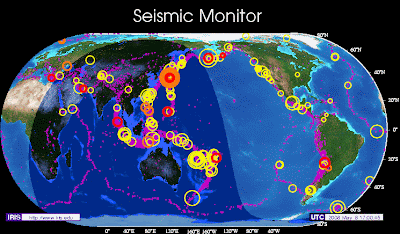
MWM: Be sure to go to the URL below this subscriber's comments.
Date: Thu, 8 May 2008 12:32:26 -0400 (EDT)
From: Charles
Subject: Re: [earthchange- bulletins] Japan rocked by 6.7 Great Quake and
multiple quakes Class 4 to 5
> BULLETIN ITEM: Japan rocked by 6.7 Great Quake and multiple quakes
> Class 4 to 5
Hello, Michael. I'm normally, critical, so in fairness, I thought I should
send a note of support for what I consider a major 'hit' for you...
Tremendous shaping event!
This latest series of quakes near Japan demonstrates the pattern that I
previously attempted to describe, as to what I would expect from a 'crust
shaping' event.... Instead of a main quake, followed by typical
aftershocks that diminish in magnitude, what happened off the coast of
Japan was a whole series of quakes with *growing* intensity, over the
course of nearly five hours, culminating in a large event that
(presumably) relieved the last of the stresses.
Of course, these are now being followed by 'standard' aftershocks, but
that cluster of quakes, including three 6+ quakes (of growing intensity!)
between 16:02 and 16:45 UTC is remarkable.
> MWM: P.S. Did we or did we not point to this possible reaction in the
> crust during this window of time from the accelerated plate motion
> which is underway?
(smile and nod) This series of quakes perfectly matches the expectations
you published, both in terms of timing, and in termd of the 'quality' of
the event. You know, looking at the usgs map, I continue to be amazed by
the remarkably *even* and broad distribution of quakes in the range of 4.6
to 5.3 around the whole globe...... Something very interesting is going
on......
Keep up the good work, Michael!
- Charles
MWM: And congrats on seeing your speculation on the "build up" of the event fully revealed. BINGO. This is an important obsevation. In principle software could see this and ring bells for us at least an hour before the BEEG one. In principle we could use the databases of the last ten years to learn how to set the criterion points. THIS IS WELL WORTH PURSUING. Speaking of worldwide distribution, I snared today's IRIS chart for the archives. Wot a classic, you can see the living Earth breathing in and out. It displays an amazingly full house (nearly) of the active zones and type of quakes. Take note, on the outer edge of the chart, of the world encircling distribution of yellow and one organge circle. I have never seen the pattern this full. The Atlantic is clearly rifting in all the major zones (mantle rising & crust expanding) while the Western Pacific (the mirror opposite) subduction zone has a full house of in its zones (crust sinking/shrinking) . What's driving it? The orbital relationships are not merely coincidental. Most of the other pirmary active active zones are also revealed, of both types, with at least one marker. Missing now is Central East Asia (that area was active last month and fell out of the time series) and East Africa and the Indian Ocean. The East Pacific Rise also seems under represented. Perhaps these three sparse zones are the next shoes to drop.
http://www.earthcha nges-bulletin. com/earthchanges /bulletin/ 2008/quakes/ worldquakes_ IRIS_5-8- 08_special. gif
BTW: I suspect the ocean surface temperatures to watch this coming 'cane season are in the Atlantic. Most likely most marine geologists will readily agree that increased magma flow and heat flow into the bottom of the Atlantic is going on as a consequence of this surge of quake activity, possibly far beyond "average" levels (at least I would assert). Generally major heat plumes will flare like solar flares, but unlike solar flares, these will persist for 30 to 90 days (or even longer - this is not well defined by science) before gradually falling off (takes a few years to fall fully back to average). What I am getting at is that the 'cane season this year may be more driven by heat in the ocean than from solar activity, which is not going to be much beyond MIN for most of this year. From the MIN I would predict a very weak 'cane season. But from this tectonic activity, I would venture a very strong Atlantic storm season. What will save the Carib basin, if save is the right word, is that low pressures in the North Atlantic are likely to lower (in latitude) the jet stream and act to pull more heavy equatorial air directly to the north. This may keep more of the large storms tracking up the Altantic rather into the Carib.
May 08, 2008
BULLETIN ITEM: Check Out This IRIS Chart
Subscribe to:
Post Comments (Atom)














No comments:
Post a Comment